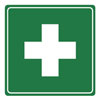First aid is medical attention that is administered immediately after an injury or illness in the location where it takes place. It often consists of a one-time, short-term treatment requiring little technology or training to administer. There are typically two types of first aid treatment.
Non-Emergency First Aid – This type of first aid is often initiated by the user for injuries or medical conditions that are not life threatening. It can include attending to minor cuts, abrasions, or scratches; treating minor burns; applying bandages; the use of non-prescription medication; draining blisters; eye cleaning; and heat stress relief. After the initial use of a first aid kit, more advanced medical care can be administered if the medical problems persist.
Emergency First Aid – This type of first aid is usually administered in response to a life-threatening illness or injury. Advanced medical care will often be needed after this initial treatment. Examples of emergence first aid can include CPR, choking, AED/heart attack, anaphylactic shock, broken bones, and severe bleeding.
Responding quickly to these emergency and non-emergency situations is an important part of any workplace safety and health program. OSHA standard 29 CFR 1910.151 requires that first aid be performed by adequately trained personnel with access to proper first aid supplies.
First Aid Signs

First Aid Posters
First aid posters give individuals immediate instruction on how to identify injuries, symptoms, and the first aid to be provided in the event of an emergency. They also will often list the steps and actions to take when an emergency first occurs and specific emergency phone numbers to call. First aid safety posters are a perfect tool for employers to use for notifying and instructing employees of the standard operating procedures in the event of an emergency.
First Aid Poster Types
These are a few of the recommended general first aid safety posters that should be added to the workplace.
- Poisoning and Burns
- CPR
- Heat and Cold Emergencies
- Shock
- Choking
- Bites and Stings
- Breathing emergencies
- Cuts and broken bones
ANSI Recommended First Aid Kit Contents
OSHA standard 1910.151 (b) states an employer must have “adequate first aid supplies…readily available,” although specific first aid supplies are not listed. OSHA does not have a minimum requirement, but references ANSI Z308.1-2003 Minimum Requirements for Workplace First Aid Kits. According to the ANSI document, a basic workplace first aid kit should include:
- At least 1 absorbent compress, 32 sq. in.
- At least 16 adhesive bandages, 1 in. x 3 in.
- One roll of adhesive tape, 5 yd. total
- At least 10 packets of antiseptic, 0.5g (0.14 fl oz.)
- At least 6 applications of burn treatments, 0.5 g (0.14 fl. oz.)
- Two or more pairs of medical exam gloves.
- At least 4 sterile pads, 3 in. x 3 in. (7.5 x 7.5 cm)
- One triangular bandage, 40 in. x 40 in. x 56 in.
Additional (but optional) items include:
- Four 2×2 inch bandage compresses
- Two 3×3 inch bandage compresses
- One 4×4 inch bandage compresses
- One eye patch
- One ounce of eye wash
- One chemical cold pack, 4 x 5 inch
- Two roller bandages, two inches wide
- One roller bandage, three inches wide
- CPR barrier device
These items are intended to be the minimum for a workplace first aid kit. Depending on the potential for injury, a more complete kit may be necessary. OSHA recommendations do not include an automated external defibrillator (AED), but current emergency cardiac care guidelines from the American Heart Association recommend AEDs in most public places.
